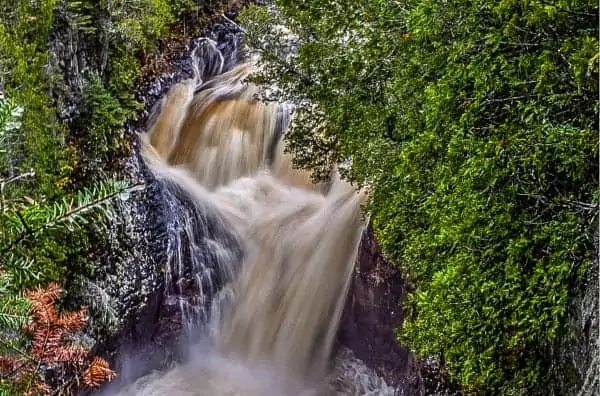 The Devil’s Kettle Waterfall. A scary-sounding name for the area’s most mysterious waterfall. Located on the Brule River flowing through Judge C.R. Magney State Park near Hovland, MN, 20 miles north of Grand Marais, MN, the Devil’s Kettle Waterfall has been baffling visitors for decades. One side of the river rumbles onto a stone embankment and down the rocks. As waterfalls typically do. The other side, however, flows into a geological wonder known as the Devil’s Kettle, and… disappears?
The Devil’s Kettle Waterfall. A scary-sounding name for the area’s most mysterious waterfall. Located on the Brule River flowing through Judge C.R. Magney State Park near Hovland, MN, 20 miles north of Grand Marais, MN, the Devil’s Kettle Waterfall has been baffling visitors for decades. One side of the river rumbles onto a stone embankment and down the rocks. As waterfalls typically do. The other side, however, flows into a geological wonder known as the Devil’s Kettle, and… disappears?
A Geological Wonder
Well, perhaps not. The mystery of the Devil’s Kettle Waterfall has been stumping visitors and geologists alike for a number of reasons. For one, the rock that the Devil’s Kettle formed into is Rhyolite. Rhyolite is formed from a volcanic eruption. It’s normal to find small kettles in this kind of rock near waterfalls because of the force of the water and the sand and rocks carried by the river flow. However, the Devil’s Kettle is special in that this isn’t a small, shallow pothole. In fact, the bottom Devil’s Kettle cannot be seen. Its true exit point remains (mostly) unknown.
So how and why the Devil’s Kettle formed the way it did is one mystery. However, the mystery most often discussed when talking about the Devil’s Kettle is where exactly the water goes once it enters the Kettle.
So, Where Does the Water Go?
There are a few theories as to where exactly the water then flows into the Devil’s Kettle goes. In 2016 geologists measured the water at the top of the waterfall and then measured the water a few hundred feet below the waterfall. They found that the amount of water was the same, despite about half of it flowing into the Kettle. Because of this, the most pervasive (and likely) theory to date is that the water flows into the Devil’s Kettle and then flows back out right at or right below the waterfall.
 However, there are a few reasons why people have doubts about this theory, even though it makes sense. Primarily because, to date, the actual location where the water re-joins the river has yet to be determined. Many people are of the mindset that the mystery isn’t solved until someone can pinpoint the precise location. Another reason for the doubting is because of all the things people have thrown into the Devil’s Kettle over the years, only to have these things disappear, never to be seen again.
However, there are a few reasons why people have doubts about this theory, even though it makes sense. Primarily because, to date, the actual location where the water re-joins the river has yet to be determined. Many people are of the mindset that the mystery isn’t solved until someone can pinpoint the precise location. Another reason for the doubting is because of all the things people have thrown into the Devil’s Kettle over the years, only to have these things disappear, never to be seen again.
Random Things We Throw Into Waterfalls
You see, before 2016 the most popular theory as the fate of the water that flowed into the Devil’s Kettle is that it traveled along with some sort of underwater cave system, or met up with an underground river/water system, and emptied out into Lake Superior about a mile and a half away. Dye, ping pong balls, GPS trackers, and more have been tossed into the kettle. Then, people would watch the river and lake, waiting for signs of the items they threw in to appear. These things were never seen again- including below the waterfall or anywhere the Brule River.
This has been explained away by geologists as being the result of the sheer force of the water flowing into and around the Devil’s Kettle. Basically, the water destroys anything sent into it. But, again, for many, seeing is believing and all they’ve ever actually seen are these items mysteriously disappearing.
The Mystery Remains
News articles regarding the 2016 findings indicated that researchers were going to return to Brule River in the fall of 2017, when water levels were low, and do another dye test to prove their theory. It appears this never happened due to the DNR highly recommending that this sort of experiment not be done, perhaps for ecological reasons. For many, this leaves the mystery of the Devil’s Kettle unsolved, wanting proof of the Kettle’s ultimate exit point before being satisfied with the answer. And until we hear otherwise, we will declare this mystery (mostly) unsolved.
Getting There
Judge C.R. Magney State Park is located at 4501 W MN-61, Grand Marais, MN. The state park is home to three waterfalls with the Devil’s Kettle being the most well-know. To get to the waterfall, start hiking inland. You will encounter many, many stairs (over 200) going down to the waterfall. Remember, when you’re done viewing the waterfall, you need to go back up. This is not an easily accessible waterfall, especially for those with mobility issues.
Listen to Joe and Jaye’s hike to the Devil’s Kettle on the Exploring the North Shore Podcast:
